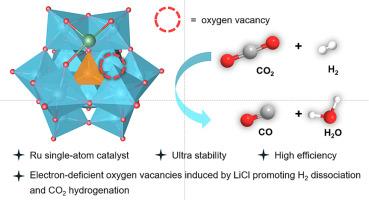碱卤化物在多金属氧酸盐上诱导出缺电子氧空位,促进CO2加氢
IF 13.2
1区 工程技术
Q1 ENGINEERING, CHEMICAL
引用次数: 0
摘要
开发有效的二氧化碳催化转化催化剂仍然是一个重大挑战。本文构建了一系列卤碱修饰的多金属氧酸盐(POM)催化剂,取代了Ru单原子,实现了CO2的高效加氢。通过XRD, ESI-MS,原位FT-IR, HAADF-STEM和XAFS表征,证实了单原子Ru被纳入POM框架中。值得注意的是,在POM表面引入LiCl调制的缺电子氧空位(OV)可以有效地促进H2的解离。单原子Ru有利于吸附CO2,形成双齿碳酸盐中间体(b-CO3)。然后,OV位点上的活性氢增强了CO2选择性加氢成CO,从而促进了逆水气转换(RWGS)反应。原位RWGS反应FT-IR和DFT计算共同揭示了缺电子OV和单原子Ru在促进H2解离和CO2吸附方面的协同效应。此外,RWGS反应产生的CO随后可以使用由铑配合物和膦配体组成的传统催化体系用于烯烃的氢甲酰化,从而实现将CO2转化为有价值的化学品。本文章由计算机程序翻译,如有差异,请以英文原文为准。

Alkali halides induced electron-deficient oxygen vacancies on polyoxometalates promoting CO2 hydrogenation
The development of catalysts for the efficient catalytic conversion of CO2 remains a significant challenge. Herein, a series of alkali halide-modified polyoxometalate (POM) catalysts with substituted Ru single atoms were constructed for efficient CO2 hydrogenation. Characterization using XRD, ESI-MS, in-situ FT-IR, HAADF-STEM and XAFS confirmed that the single-atom Ru were incorporated into the POM framework. Notably, the introduction of LiCl modulating electron-deficient oxygen vacancies (OV) on the POM surface can effectively promote the dissociation of H2. Moreover, the single-atom Ru facilitated the adsorption of CO2 and formed the bidentate carbonate intermediate (b-CO3). Then, the reactive hydrogen species on the OV sites enhanced the selective hydrogenation of CO2 to CO, thereby promoting the reverse water gas shift (RWGS) reaction. In-situ RWGS reaction FT-IR and DFT calculations jointly revealed the synergistic effect of electron-deficient OV and single-atom Ru on promoting H2 dissociation and CO2 adsorption. In addition, the CO produced from the RWGS reaction can be subsequently utilized in the hydroformylation of olefins using a conventional catalytic system consisting of rhodium complex and phosphine ligands, thereby achieving the conversion of CO2 into valuable chemicals.
求助全文
通过发布文献求助,成功后即可免费获取论文全文。
去求助
来源期刊

Chemical Engineering Journal
工程技术-工程:化工
CiteScore
21.70
自引率
9.30%
发文量
6781
审稿时长
2.4 months
期刊介绍:
The Chemical Engineering Journal is an international research journal that invites contributions of original and novel fundamental research. It aims to provide an international platform for presenting original fundamental research, interpretative reviews, and discussions on new developments in chemical engineering. The journal welcomes papers that describe novel theory and its practical application, as well as those that demonstrate the transfer of techniques from other disciplines. It also welcomes reports on carefully conducted experimental work that is soundly interpreted. The main focus of the journal is on original and rigorous research results that have broad significance. The Catalysis section within the Chemical Engineering Journal focuses specifically on Experimental and Theoretical studies in the fields of heterogeneous catalysis, molecular catalysis, and biocatalysis. These studies have industrial impact on various sectors such as chemicals, energy, materials, foods, healthcare, and environmental protection.
 求助内容:
求助内容: 应助结果提醒方式:
应助结果提醒方式:


